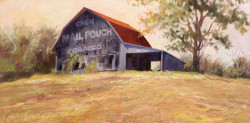The following post contains excerpts from a 2012 presentation by Charles Leik, Past President, NBA. Charles led the NBA for more than five years and was around in the years when the NBA lobbied the USDA to ask farmers about their historic barns in the 2007 Agricultural Census. (NBA also thanks Rod Scott and countless others who worked on behalf of historic barns across the country to get the USDA’s attention!)
What is a barn? For me a barn houses cattle and horses or stores grain, hay and straw, or is dedicated to tobacco or hops drying. Most of us think of barns as massive gambrel or gable structures to house livestock in winter. I do not include pole structures as barns when I think of preservation! I do believe that urban carriage houses that once contained a family’s buggy horse and milk cow and are often highly refined Victorian structures, do qualify as barns.
What is America’s barn population? There is no authoritative number even if all questionnaire respondents were to use a uniform definition for a barn. A 2007 USDA census of farmers and ranchers with more than $1,000 of farm income asked if they owned a barn built before 1960 (this would’ve excluded most pole structures). The results indicated 650,000 barns, however it excluded multiple barns on the same property, barns no longer located on farms, barns owned by non-farming landlords, and did not consider the condition of the barn. Fifteen percent of the questionnaires were not returned.
Allowing for the shortcomings mentioned above, Texas registered 51,000 barns, Missouri 36,000, Wisconsin 35,000, Kentucky 35,000 and Iowa 34,000. In terms of density per square mile it was Kentucky, Ohio, Tennessee, Pennsylvania and Wisconsin. Michigan was 13th in barn population with 21,368 and 14th in barn density at an average of one for every three square miles.
I find the USDA results unsatisfying given the barns excluded and lack of a uniform definition. Let me approach this question using U.S. census figures. There were 2.04 million farms at the advent of the Civil War in 1860 to a high of 6.5 million in 1920. Farms declined to 3.7 million in 1960 and 2.17 million in 2010. Assuming there is a pre-1960 barn, no matter the condition, on 75 % of the 2010 farms, I would guesstimate 1.5 million barns currently exist on farms.
Note that urban carriage houses or barns no longer on farms are excluded in the 1.5 million, and I believe they are a sizable number. The problem is that a good proportion of my 1.5 million barns on farms are in such a deteriorated condition that their eventual demise is certain.
I took a last approach, interesting but not statistically correct, and reviewed the barns I can recall since 1950 on 3-miles of Keefer Hwy., Portland where our family’s Centennial Farm is located. In 1950 there were 12-barns of which 6-7 sheltered livestock and two of these were dairies.
Currently there are six barns—none in active farm use. I believe based on their condition that four will remain in 2030. So, 80-years after 1950 only one-third of this barn sample will exist.
I consider 1950 the “High Water Mark” of barn population. Probably most barns on the 6.5 million farms in 1920 still existed in 1950 and relatively few barns were built in the 25-year period after the farm depression of the early 1920s, the Great Depression of 1929 and the scarcities of WWII. My opinion is that six million barns existed in 1950, whether located on farms or not. Today, 62-years past the “High Water Mark”, I’d offer for your consideration that approximately two-thirds of the 1950 barns are either gone or going down.
In conclusion I guesstimate that 1.5-2.0 million of pre-1960 barns in all locations exist today in a fair to good condition. That is the barn universe that we preservationists are attempting to save. 2050 is only 38-years in the future, what percentage of barns will remain a century after the “High Water Mark”? They say, “Those that gaze at crystal balls to divine the future will be condemned to eat glass”. Nevertheless I’ll venture that 20 % of the 1950 barns or 1.2 million will remain in a condition ranging from excellent to decrepit.
The romantic in me considers a barn as a trophy or heritage building whilst for others it’s a “money pit” requiring too many squares of shingles or gallons of paint. My hope is that “scarcity makes the heart grow fonder“and barns in 2050 like covered bridges today will be generally revered.

